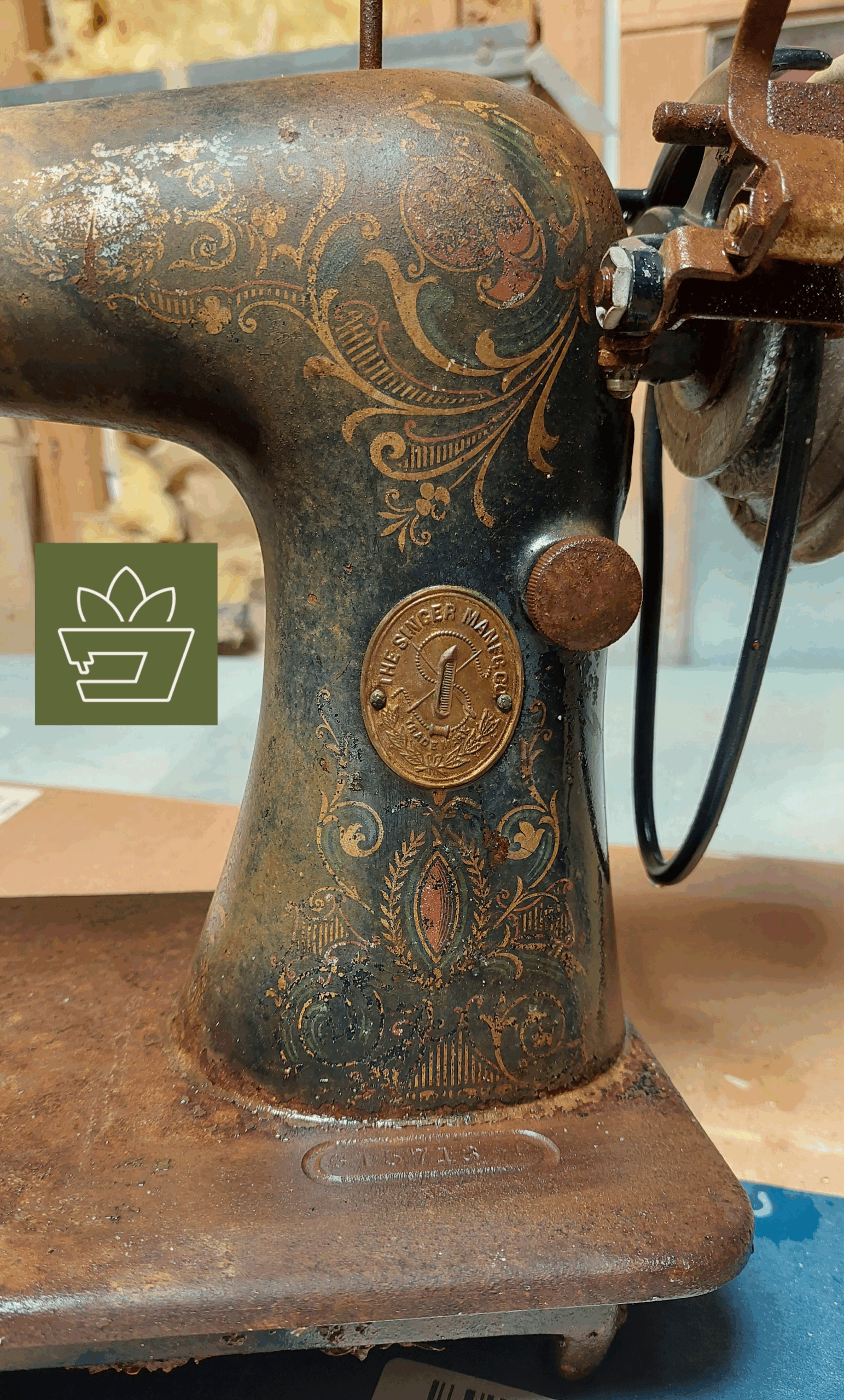Your cart is currently empty!

Gilded Threads: Preserving Antique Sewing Machine Decals
Antique sewing machines aren’t just functional tools; they’re pieces of art. Nowhere is that more evident than in their intricate decals: gold filigree, exotic florals, mythical beasts, and cultural motifs that were as much about marketing as they were about beauty. These decals tell a visual story of industrial design, regional taste, and innovation, if you know where to look. In this post, we’ll explore the origins of antique sewing machine decals, some of the most iconic and unique designs, and how to care for them today.
The First Flourishes: Early Decal Designs
The earliest sewing machines from the mid-1800s had simple or no decoration. But as companies like Singer, Wheeler & Wilson, and Jones began to compete for home markets in the 1870s–1900s, ornamentation became essential as they sought to capture the customers’ attention.
Singer introduced elaborate gold decals inspired by Victorian aesthetics—scrolls, Greek key patterns, and flowers. These were applied using a dry transfer process and finished with shellac or clear lacquer.
Early examples include:
- “Fiddle Base Scrollwork” (1860s–1870s): Found on Singer 12 models
- “Acanthus Leaves”: A common design on late 1800s treadles
- “Victorian Egyptian Revival”: A trend in the 1880s following global archaeological discoveries
The Most Popular & Unique Antique Sewing Machine Decals

One of the most iconic decal sets is Singer’s “Red Eye”, featured on Model 66 machines from the 1910s–1920s. Named for its vivid red and green concentric designs, it’s one of the most recognizable and collectible looks. Here at Revive Sewing LLC, we recently uncovered a set of Red Eye decals under a horrendous layer of grime and surface rust on this machine that came to our workshop. While the beauty is apparent, only time will tell if conservation efforts will be enough to preserve these.
Other notable styles:
- Lotus: Found on Singer 66 and 99 models, evoking Eastern botanical art
- Acanthus Leaves: Found on Singer class 12 “New Family” machines.
- Tiffany or Gingerbread: Intricate floral patterns used from 1899 to 1930. See a gorgeous example of a restoration of a Singer 15 with this design over at PungoLiving.
- Floral designs, like daisies and apple blossoms, graced many models of machines, particularly the Singer model 24.
Want to explore more decal styles from Singer? Check out ISMACS’ decal database.
Who Designed Sewing Machine Decals?
The specific artists who designed the decals on most sewing machines are largely unknown. In particular, Singer did not credit individual artists or designers for decal artwork in most of its records, which was common practice at the time for industrial manufacturers. However, we do know a few key facts:
- Singer employed in-house designers and artists, particularly from the Design and Engineering departments in its main factories in Elizabethport, NJ and Clydebank, Scotland.
- The artists who created these decals were influenced by prevailing design trends of their eras:
- Victorian florals and gold leaf in the mid-to-late 1800s
- Aesthetic Movement and Orientalism in the 1880s–1890s
- Art Nouveau and Egyptian Revival in the 1900s–1910s
- Art Deco and Streamline Moderne in the 1920s–1940s
- While Singer designed the decals in-house, the actual decals were often produced by specialist lithography firms, especially in the early years. The American Decalcomania Company was a notable production house among various transfer printing and lithographic companies in the U.S. and UK.
How to Care for Antique Decals
Original decals are delicate. Most were applied with water-slide or dry transfer methods and sealed with shellac. Over time, friction, moisture, and UV exposure can wear them away.
Tips to preserve decals:
- Keep machines out of direct sunlight to prevent fading.
- Avoid water and harsh cleaners. Use a dry microfiber cloth or a soft brush to remove dust.
- Never use alcohol-based products. Alcohol will soften the shellac finish protecting the decals, allowing moisture to seep in and exposing the decals to air through micropores.
- Clean with sewing machine oil. After you wipe down with a dry microfiber cloth, use a soft cloth with some sewing machine oil on it to wipe down the entire machine.
Why Do Antique Sewing Machine Decals Turn Silver?
Many decals appear gold when new but shift to a dull silver over time. This “silvering” happens when the clear lacquer or shellac breaks down, exposing the metallic transfer beneath. What’s left is oxidized aluminum or brass, stripped of its protective topcoat.
While silvering can’t be reversed without restoring or repainting, it tells a visual story of the machine’s age and use. For some collectors, that wear is part of the charm.
The Beauty in the Wear
Whether bright and shining or gently worn, antique sewing machine decals connect us to the hands and homes of the past. With gentle care and attention, they’ll continue to tell their stories—one stitch, and one swirl, at a time. Contact us if you need help conserving or restoring an antique sewing machine of your own.
